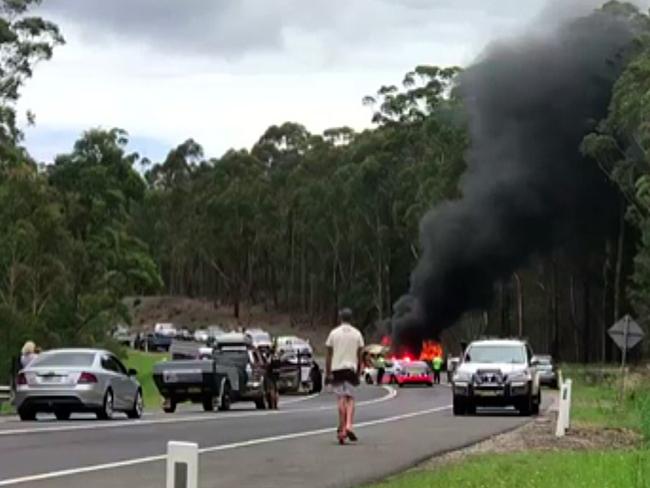THE number of roadside drug tests will double, the Highway Patrol is facing a massive shake-up, country speed limits could be cut and police are demanding kerbside cocaine tests after the state’s annual road toll soared to 393, its highest in seven years.
With families torn apart, police officers traumatised by repeatedly having to clean up horrific crash scenes and the cost to the community soaring, Traffic and Highway Patrol commander Assistant Commissioner Michael Corboy and top state cop, Commissioner Mick Fuller, have put a suite of road safety measures on the table, including slashing 20km/h off the legal limit in some parts of the bush.
The decision to act was galvanised by a horror Christmas holiday period in which 29 people died between December 15 and January 2, almost double the figure for the same period a year earlier.
One of the greatest problems has been the rise of driving under the influence of drugs, with the deaths caused now exceeding drink-driving. Latest statistics show that between 2012 and 2016, drink-driving accounted for 16 per cent of fatal crashes, while drug-driving caused 18 per cent.
They also reveal that more than two-thirds of road deaths happened in the country, where only a third of the population live, a statistic that has prompted police to discuss reducing speed limits in rural areas, particularly on dirt roads.
Highway Patrol resources were pulled out of Sydney and reassigned to country areas over Christmas and New Year after police identified remote roads as crash hot spots. Yet the majority of the fatalities were single-vehicle crashes on country roads.

The statistics have reinvigorated discussion about whether speed limits on some country roads should be cut from 100km/h to 80km/h.
“The people in regional areas think they are not the ones having the crashes,” Mr Corboy said. “But all our research shows most of those people, except a couple, died within 100km of their home. It is country people dying on country roads.”
The debate has the support of Mr Fuller, who said although country residents would not be impressed with speed limits being cut “we can’t continue to see hundreds of people die on our roads”.
He is also considering changing the highway patrol statewide model to create smaller “hubs of service delivery in the bush”.
“I will be looking at the highway patrol model this year and working with traffic and highway and the region commanders to see if there is a regional model that will give me greater visibility,” he said.

The southern region, including Wollongong, Griffith and Wagga Wagga, was flooded with police resources over the holiday break as its road toll for the year was 21 above that of 2016. However, 11 fatal crashes still occurred in that area, including the crash that claimed the lives of Vivian and Lars Falkholt and their daughter Annabelle, and left her sister, actor Jessica Falkholt, fighting for life.
Last year’s toll of 393 was nine more than 2016 and the third consecutive annual increase.
While speeding remains the leading cause of road deaths, Centre for Road Safety figures reveal the significant threat posed by drug-driving.
Mr Corboy issued a directive to officers around the state on Friday to increase random drug testing, coinciding with a new goal to double the annual number of drug tests from 100,000 to 200,000.
“It’s a shared commitment between government and police,” Mr Fuller said. “That is new funding — more money will need to come to do the testing, more money will need to come to put police out in the field to achieve that.
“At the moment we don’t test for all drugs and the challenge … going forward is what will we test for at the end of 2018.”

As it stands, roadside drug tests only detect the presence of cannabis, methamphetamine and ecstasy, whereas cocaine is picked up through a blood test. If police suspect a driver is under the influence of cocaine, they can take the person to hospital for a blood test.
“We’ve got to a stage where it is now socially unacceptable for friends to allow friends to drive drunk,” Mr Corboy said.
“But it appears that hasn’t happened yet with drug-driving. Until that changes we are going to have a fight on our hands.”
Cocaine has not so far been a major factor in serious car crashes, with only 11 drivers or riders involved in fatal accidents between 2012-16 recording evidence of the drug.
This is compared to 292 drivers having cannabis, ice or ecstasy in their system. But that is likely to change, with testing of Sydney’s waste water outlets last year revealing cocaine use in the city soared above any other area in Australia.
Mr Fuller said including cocaine in roadside drug testing would have a “positive outcome on the road toll and road safety”.


Add your comment to this story
To join the conversation, please log in. Don't have an account? Register
Join the conversation, you are commenting as Logout
Deer in the headlights or really good cop? Who is Karen Webb
Karen Webb has become our most divisive public servant since she was appointed NSW’s first female Police Commissioner in 2021. With her exit from the job looming, here’s the inside story of her time in the role.
Everyday heroes: Regional NSW residents land Oz Day honours
Not all heroes wear capes – and it couldn’t be more true for these everyday champions from Regional New South Wales who have been honoured this Australia Day. See the full list.